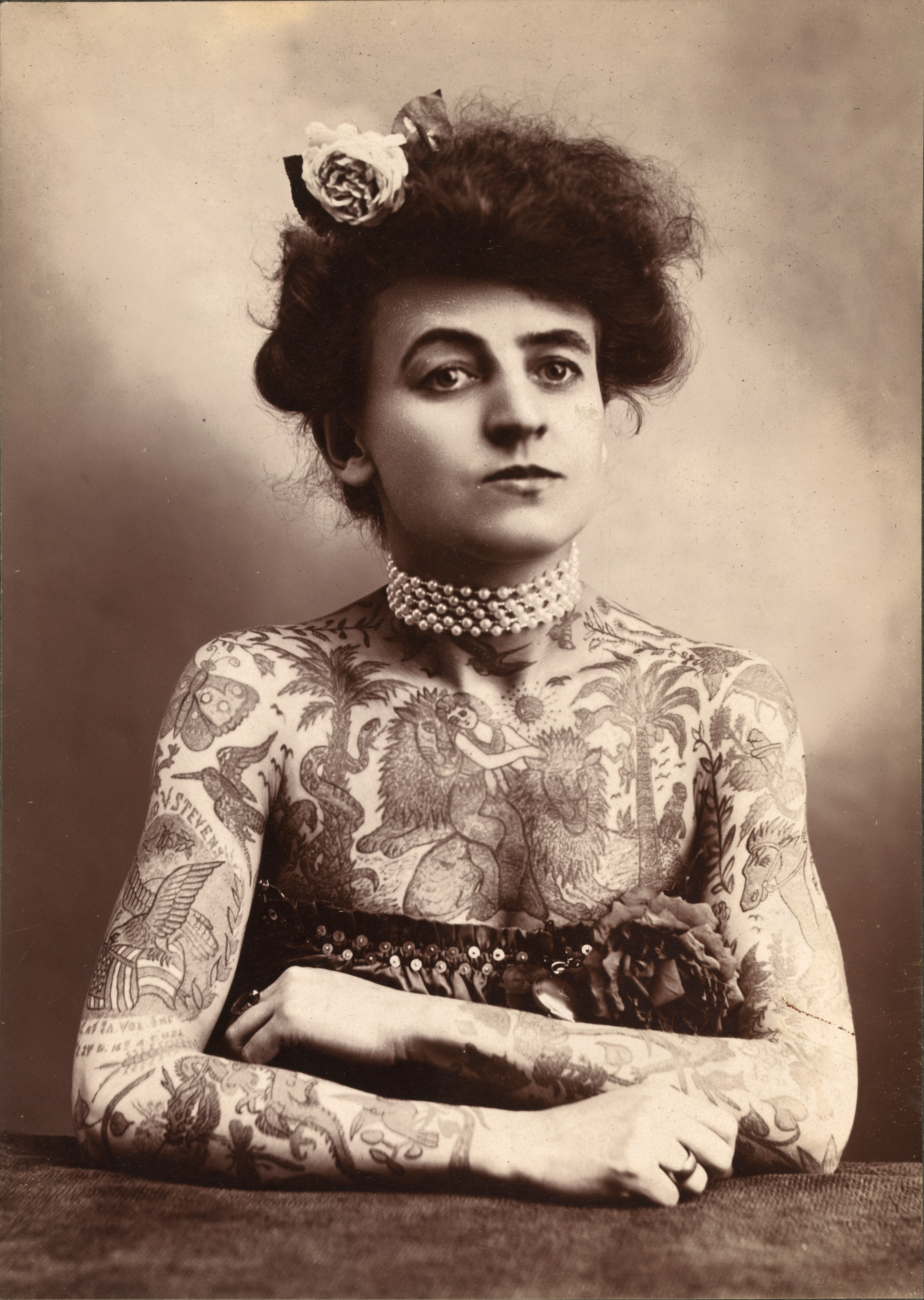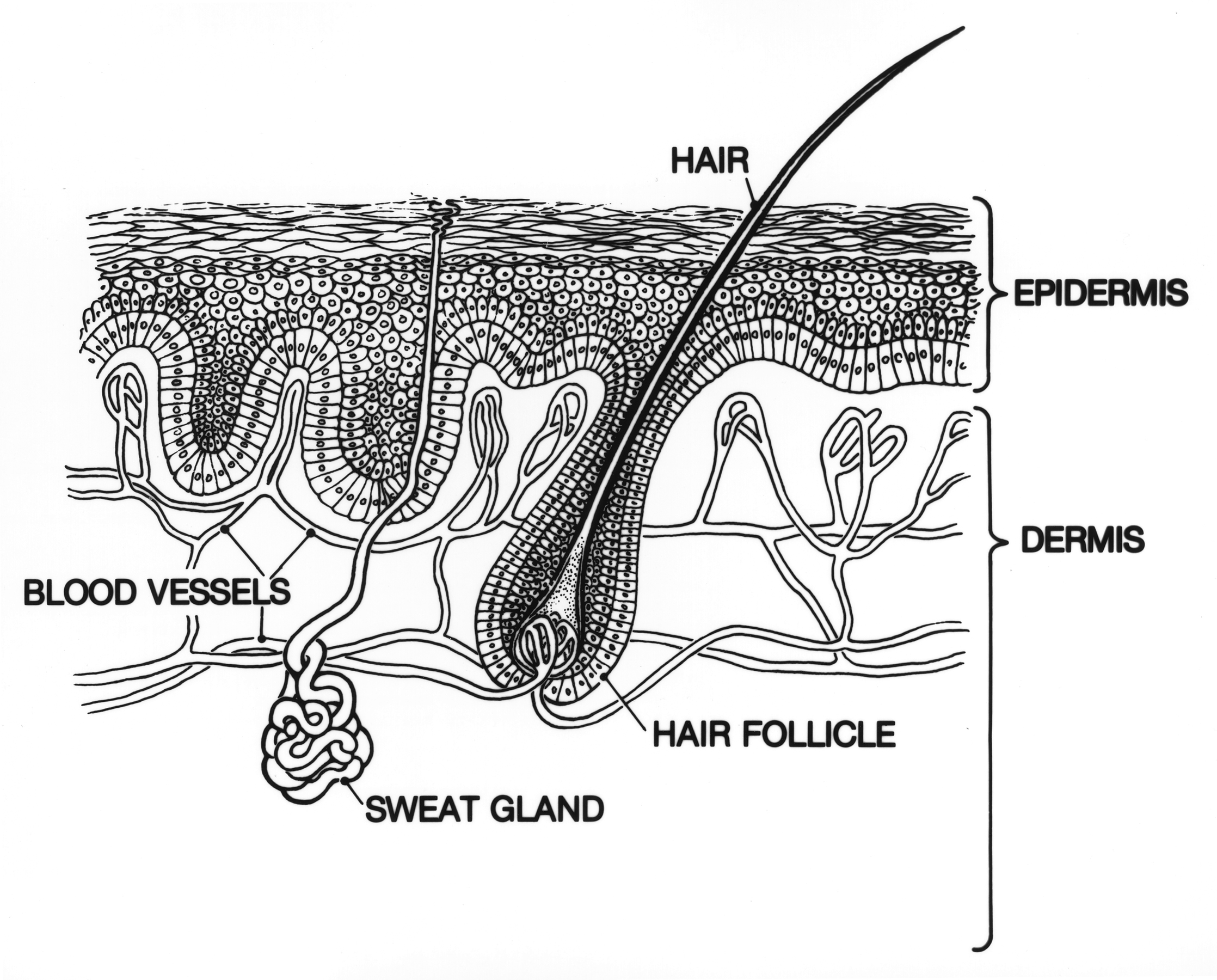How Does Skin Work With Other Systems To Keep The Body Healthy
thirteen.2: Introduction to the Integumentary Arrangement
- Folio ID
- 16796
This is Maud Stevens Wagner, a tattoo creative person who is pictured in Figure \(\PageIndex{1}\). Maud was pictured in 1907. Conspicuously, tattoos are not simply a tardily 20th and early 21st-century tendency. They take been popular in many eras and cultures. Tattoos literally illustrate the biggest organ of the human body: the skin. The skin is very thin, but it covers a large expanse — about 2 yard2 in adults. The skin is the major organ in the integumentary organisation.

What Is the Integumentary System?
In addition to the peel, the integumentary arrangement includes the hair and nails, which are organs that abound out of the pare. Considering the organs of the integumentary system are mostly external to the trunk, you may think of them every bit trivial more than accessories, like clothing or jewelry, merely they serve vital physiological functions. They provide a protective covering for the body, sense the environment, and help the trunk maintain homeostasis.
The Skin
The peel is remarkable not only because it is the trunk's largest organ. It is remarkable for other reasons as well. The average square inch of skin has 20 blood vessels, 650 sweat glands, and more than a thousand nerve endings. It also has an incredible threescore,000 pigment-producing cells. All of these structures are packed into a stack of cells that is just 2 mm thick, or most every bit thick as the encompass of a book. Although the pare is thin, it consists of two distinct layers, the epidermis and dermis, as shown in Figure \(\PageIndex{ii}\).

Outer Layer of Peel
The outer layer of skin is the epidermis. This layer is thinner than the inner layer, the dermis. The epidermis consists mainly of epithelial cells, called keratinocytes, which produce the tough, fibrous protein keratin. The innermost cells of the epidermis are stem cells that divide continuously to class new cells. The newly formed cells move up through the epidermis toward the skin surface, while producing more than and more than keratin. The cells become filled with keratin and die by the fourth dimension they reach the surface, where they form a protective, waterproof layer. As the dead cells are shed from the surface of the skin, they are replaced by other cells that movement upwardly from beneath. The epidermis also contains melanocytes, the cells that produce the chocolate-brown pigment melanin, which gives pare most of its color. Although the epidermis contains some sensory receptor cells, called Merkel cells, it contains no nerves, blood vessels, or other structures.
Inner Layer of Peel
The dermis is the inner and thicker layer of skin. Information technology consists mainly of tough connective tissue and is attached to the epidermis by collagen fibers. The dermis contains many structures, equally shown in the figure above, including claret vessels, sweat glands, and hair follicles, which are structures where hairs originate. In addition, the dermis contains many sensory receptors, nerves, and oil glands.
Functions of the Pare
The pare has multiple roles in the trunk. Many of these roles are related to homeostasis. The skin'south main functions include preventing water loss from the body and serving as a barrier to the entry of microorganisms. Another function of the skin is synthesizing vitamin D, which occurs when the skin is exposed to ultraviolet (UV) light. Melanin in the epidermis blocks some of the UV low-cal and protects the dermis from its dissentious effects.
Some other important function of the skin is helping to regulate torso temperature. For example, when the body is too warm, the skin lowers body temperature past producing sweat, which cools the trunk when it evaporates. The skin also increases the amount of claret flowing near the body surface through vasodilation (widening of blood vessels), bringing heat from the trunk cadre to radiate out into the surround.
Pilus
Hair is a fiber that is found merely in mammals. It consists mainly of keratin-producing keratinocytes. Each pilus grows out of a follicle in the dermis. By the time the hair reaches the surface, it consists mainly of dead cells filled with keratin. Pilus serves several homeostatic functions. Head hair is important in preventing heat loss from the head and protecting its pare from UV radiation. Hairs in the olfactory organ trap grit particles and microorganisms in the air and prevent them from reaching the lungs. Hair all over the body provides sensory input when objects brush against it or information technology sways in moving air. Eyelashes and eyebrows protect the eyes from water, dirt, and other irritants.
Nails
Fingernails and toenails consist of dead keratinocytes that are filled with keratin. The keratin makes them hard but flexible, which is important for the functions they serve. Nails prevent injury past forming protective plates over the ends of the fingers and toes. They also enhance sensation past interim as a counterforce to the sensitive fingertips when objects are handled. In add-on, fingernails can be used as tools.
Interactions with Other Organ Systems
The skin and other parts of the integumentary system work with other organ systems to maintain homeostasis.
- The skin works with the allowed system to defend the torso from pathogens by serving as a physical barrier to microorganisms.
- Vitamin D is needed by the digestive organisation to absorb calcium from nutrient. By synthesizing vitamin D, the skin works with the digestive system to ensure that calcium can be captivated.
- Most immune cells, such every bit B and T cells have Vitamin D receptors. Vitamin D levels in the trunk are associated with autoimmune diseases and immune deficiencies.
- To control torso temperature, the skin works with the cardiovascular system to either lose body heat or conserve it through vasodilation or vasoconstriction.
- To observe sure sensations from the outside world, the nervous system depends on nervus receptors in the peel.
Review
- Name the organs of the integumentary arrangement.
- Compare and contrast the epidermis and dermis.
- Identify the functions of the pare.
- What is the composition of hair?
- Describe 3 physiological roles played past the pilus.
- What practice nails consist of?
- List two functions of nails.
- What do the outermost surface of the skin, the nails, and hair accept in mutual, in terms of their composition?
- The innermost layer of the epidermis consists of _________ cells than the outermost layer of the epidermis.
A. older
B. younger
C. more sweat glands
D. more blood vessel
- Place two types of cells found in the epidermis of the pare and draw their functions.
- Truthful or False. Keratin-producing cells in the epidermis are a type of epithelial cell.
- True or Imitation. Vasodilation is used to warm the body.
- Which construction and layer of peel do hair grow out of?
- Place 3 master functions of the integumentary system and give an instance of each.
- What are 2 ways in which the integumentary arrangement protects the body against UV radiation?
Explore More
Source: https://bio.libretexts.org/Bookshelves/Human_Biology/Book:_Human_Biology_%28Wakim_and_Grewal%29/13:_Integumentary_System/13.2:_Introduction_to_the_Integumentary_System
Posted by: grahamwhings.blogspot.com

0 Response to "How Does Skin Work With Other Systems To Keep The Body Healthy"
Post a Comment